
Previous Shows
August 2004
Hour 25 Home Page
This Week's Show
Upcoming Shows
Audio Index
Current Calendar
Last Month's Calendar
On-Going Events
Authors on Tour
Literacy Education
Hour 25 Background
Links
Index to our previous shows
Dr. Frank Drake Listen to this show
|
On Thursday - August 26rd, 2004 - our guest was Dr. Frank Drake of the SETI Institute chatting with us about the Search for Extra-Terrestrial Intelligence. {SETI} If there is any idea that defines science fiction it is that of contacting a non-human intelligence. But what is more exciting than any fictional story is the idea that we might actually communicate with intelligent creatures from another world. For many years one of the leading figures in the SETI field has been Dr. Frank Drake. He lead the first serious attempt to listen for radio signals from non-Terrestrial civilizations - back in the 1960's - and for more than four decades has been a guiding light for most SETI activities. In the early 1960's he attempted to quantify the estimates for the number of communicative intelligences in the galaxy and this lead to the now famous "Drake Equation". {A bastardized version of which was used in Gene Rodenberry's original pitch for Star Trek.} We had the chance to speak with Dr. Drake at a space conference a while back. It was a pleasure and an honor to get to spend time with someone who has been so instrumental in forming our ideas for how humans might communicate with other intelligences in our universe. |
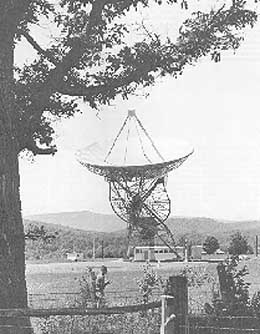 The Project Ozma Radio Telescope, which was used by Dr. Drake for the first SETI observations. |
 Image courtesy of SETI Institute. All Rights Reserved. |
Dateline: Mars
NASA is releasing all of the images from the two Mars Exploration Rovers almost as soon as they arrive at JPL. The raw images for the Spirit rover can be found at this Web Page and raw images for Opportunity can be found here. The images that have been released to the press, along with animations and explanatory text, can be found here. You can find larger versions of the images shown below at that last NASA Web Site.
Opportunity |
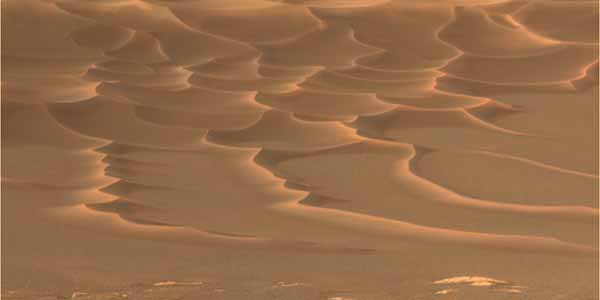 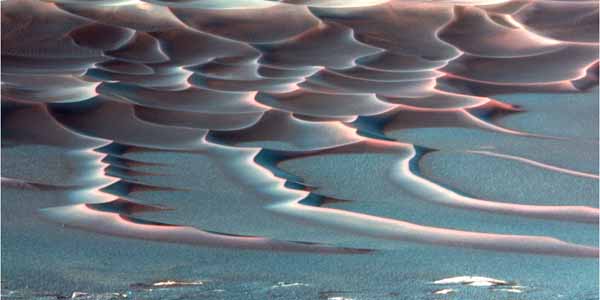 Image Credit: NASA/JPL |
|
While Opportunity continued to explore Endurance Crater it returned the above images of the dunes lying on the crater's bottom. Analysis of the false color images, like the lower of the above two images, is helping the geologists to understand the composition and grain size distribution of the materials within these dunes. |
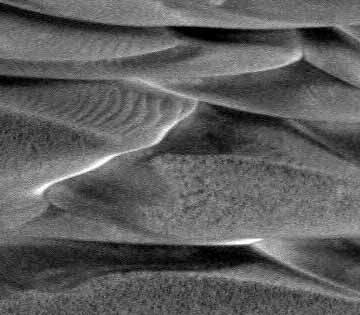 Image Credit: NASA/JPL |
|
Analysis of higher resolution versions of those and other images show that there are are a series of successively smaller ripples on these dunes, which suggests that the activity that formed them is continuing into the present time. |
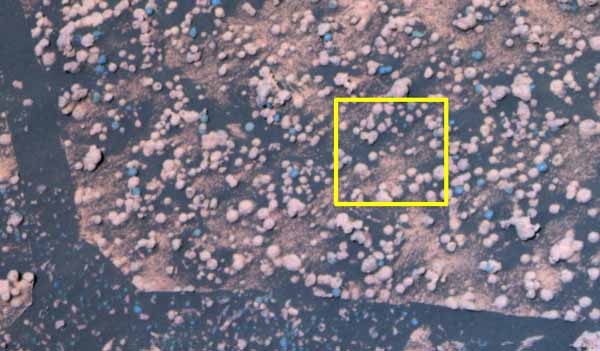 Images Credit: NASA/JPL |
|
Opportunity has returned many pictures of the now famous "blueberries", those hematite rich smooth-surfaced spherical rocks that appear bright blue in the false color images. Now it has found something new - "popcorn". The "popcorn" rocks are slightly larger than the "blueberries" and have a frothy surface. The image above shows a false color view of a mixed group of "blueberries" and "popcorn". The yellow box marks the area shown in the enlarged images below. |


Images Credit: NASA/JPL |
|
And surprise of surprises, the "popcorn" rocks turn out to be "blueberries" with some kind of crust. Understanding how they formed is sure to provide another clue to the geology of Mars and will tell us much about the history of water on Mars. |
|
|
Spirit |
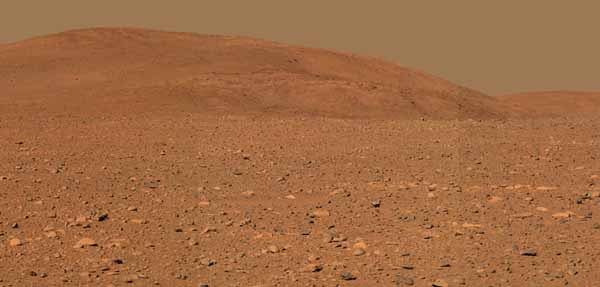 Image Credit: NASA/JPL |
|
Spirit has now reached the "Columbia Hills" and is continuing its program of exploration by driving up the side of those hills. This will also allow it to find a place where it can get a bit more sunlight during the Martian winter and thus stay warmer and get more energy from its solar panels. |
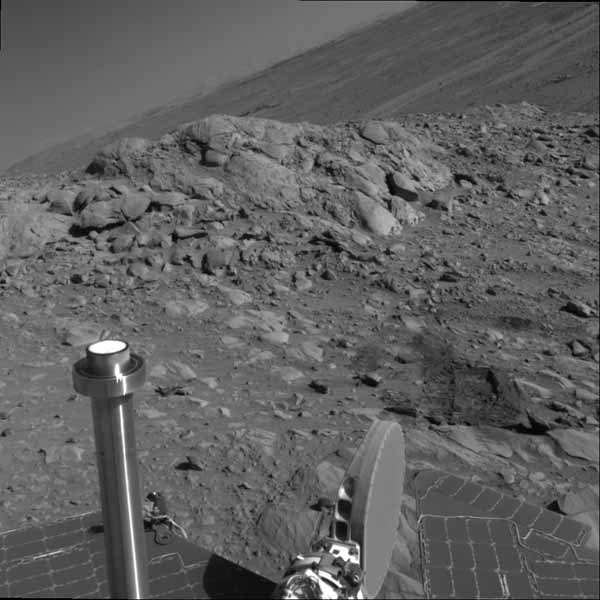 Image Credit: NASA/JPL |
|
Here is an image that Spirit took from a vantage point on the side of the "Columbia Hills". Note how the horizon is tilted due to the slope of the hill. This tilt is also what will be providing the rover with a bit more power from its solar arrays since they can be pointed a bit more directly at the Sun. |
 Image Credit: NASA/JPL |
|
This true color mosaic has been adjusted so that the horizon is no longer tilted. Scientists were surprised and pleased to discover that this rock outcrop contains some local bedrock and that those rocks show evidence of standing water in the Martian past. |
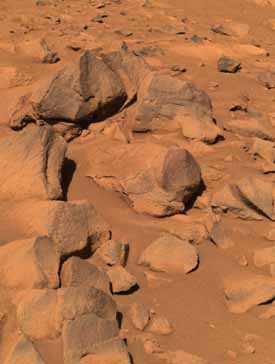
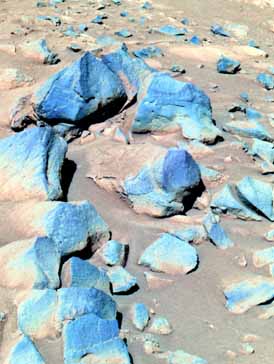 Image Credit: NASA/JPL |
|
This pair of images, the one on the left is true color and the one on the right is in false color, show some rocks on the Martian surface that appear to have some of the freshest exposed surfaces of any rocks seen by the two rovers. |
Listen to this show | |
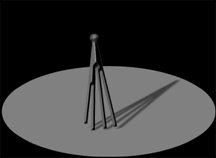
|
|
Links for more information relating to this week's show
|
Dr. Frank Drake and SETI
Space Related Organizations If you are interested in learning more about current space activities there are many local and national organizations you might want to know about. Joining these organizations and taking part in their activities is a good way to stay abreast of things going on in space as well as a way to show your support for those activities. Listed below are some of those organizations. Space News - Mars Space News - The Cassini Mission to Saturn For On-Going Updates on Space News ISS News |
Kim Stanley Robinson Listen to this show
|
On Thursday - August 5th, 2004 - our guest will be author Kim Stanley Robinson, chatting with us about his newest book Forty Signs of Rain and other subjects. Stan Robinson has been writing memorable science fiction since the 1980's. His book Icehenge was a fascinating exploration into the nature of memory and the relationship between memory and objective reality. His Red/Green/Blue Mars trilogy is justifiably one of the most famous science fictional explorations of the topic of Terraforming. Years of Rice and Salt is a fascinating alternate history that examines how the world would be different if European society had been killed off by the Black Death during the Middle Ages. And..... well I could go on, but you get the picture. Stan's books are always memorable and shape the nature of contemporary science fiction. Stan's newest book, Forty Signs of Rain, is no exception to this pattern. This book, which is the first installment of a new series, sets the stage for an exploration of the impact of global warming on the fate of civilization. In this book we watch as various characters become aware of the reality of global warming and what it is doing to the environment and our civilization. Since this book is the lead-off volume in a new series it has to spend a lot of time introducing characters and situations, creating problems and developing them, and - in general - laying the foundation for the rest of the story developments. In the hands of a lesser writer this could be the kiss of death, but Stan did a masterful job of getting me hooked on the characters and their problems. Forty Signs of Rain was a very satisfying read that left me hungry for the next installment of the series. I enjoyed this book a great deal and commend it to your attention. | ||
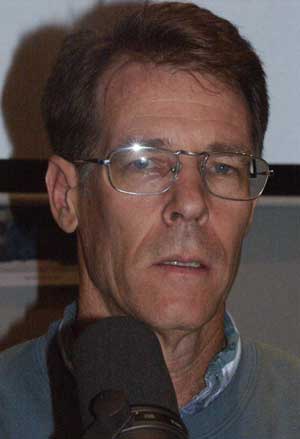
|
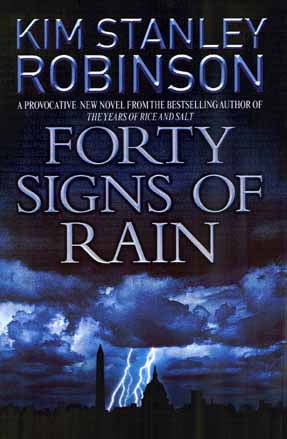
| |
Dateline: Mars
NASA is releasing all of the images from the two Mars Exploration Rovers almost as soon as they arrive at JPL. The raw images for the Spirit rover can be found at this Web Page and raw images for Opportunity can be found here. The images that have been released to the press, along with animations and explanatory text, can be found here. You can find larger versions of the images shown below at that last NASA Web Site.
Opportunity |
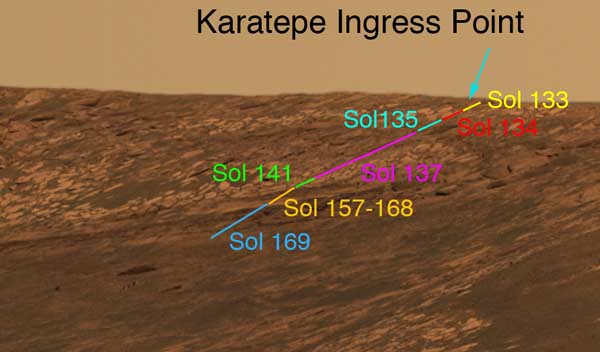 Image Credit: NASA/JPL |
|
The picture above shows the route that Opportunity is taking as it continues its descent into Endurance Crater. |
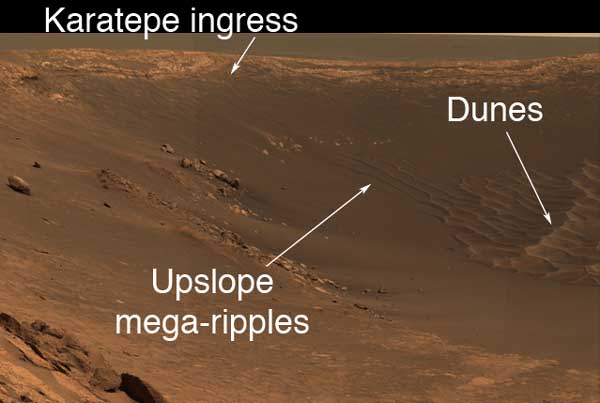 Images Credit: NASA/JPL |
|
Here you see some of the geologic features within Endurance Crater, along with the area where Opportunity is making its descent. |
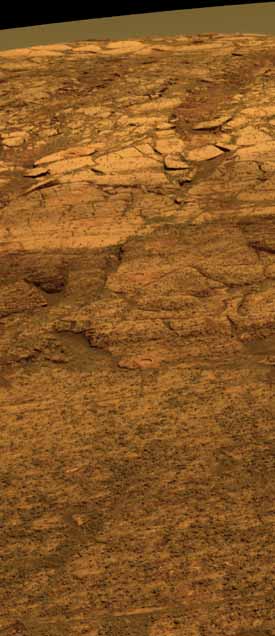
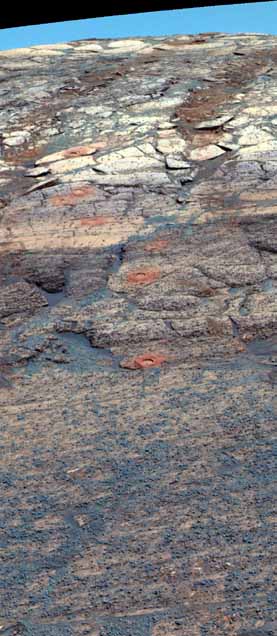
Image Credit: NASA/JPL |
|
The true color image on the left shows you some of the layered rocks that Opportunity is investigating. Scientists have been using the Rock Abrasion Tool (RAT) to drill through the surface layers of these rocks to determine the effects of surface weathering and to get at pristine samples. If you look carefully at this image you will find over half a dozen places where the RAT has drilled into the rocks. The scientists refer to those places as 'RAT holes'. The false color image on the right shows the same area as the left picture. However this image was processed so that the colors correspond to different rock compositions and particle sizes, not the actual color of the rocks. This lets the scientists study the distribution of different rock types and thereby get an understanding of the processes that created this landscape. {And it also makes it easy to see the 'RAT holes' since the drilling process uncovers rocks that have not been modified by surface weathering processes and creates piles of dust that have particle sizes significantly different from the unmodified rocks.} |
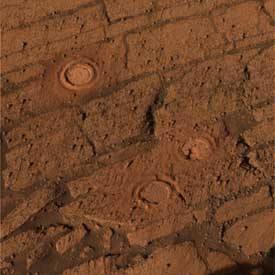
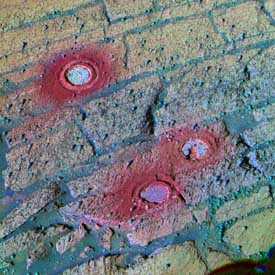
Image Credit: NASA/JPL |
|
The above two images show a true color image of some 'RAT holes' on the left and an enhanced color version on the right. The enhanced color image exaggerates the colors by making the reds redder and the blues bluer. This brings out subtle color variations and helps the scientists study compositional and texture variations in the rocks. To give you a sense of scale, each RAT hole is 1.8 inches (4.5 cm) in diameter. |
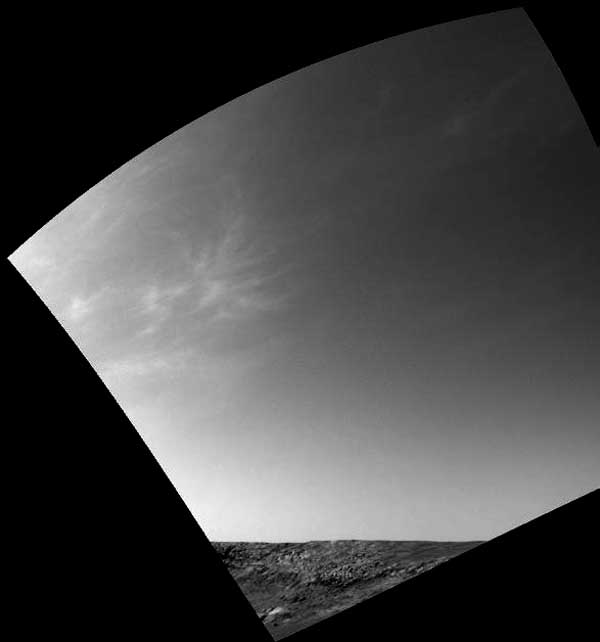 Image Credit: NASA/JPL |
|
And here is something you don't see very often on Mars. Clouds. |
|
|
Spirit |
 Image Credit: NASA/JPL |
|
This image shows the route that Spirit has taken since it landed in Gusev Crater on January 3, 2004. So far it has covered a bit over 2.2 miles (3.5 kilometers) and has arrived at the "West Spur" region of the "Columbia Hills". This image was created using data from the camera on NASA's Mars Global Surveyor spacecraft. The colors on this image are based on the results from geological mappings of the Martian surface and represent the different geologic units and rock types found there. |
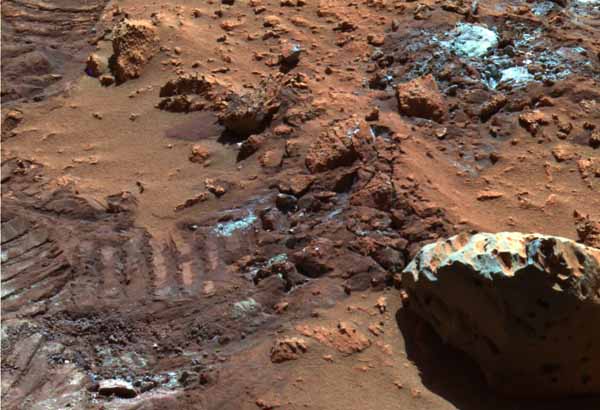 Image Credit: NASA/JPL |
|
This false-color image shows the rover's tracks along with some sparkly dust-like material that was created when the Martian soil was disturbed. Every time we turn around, Mars shows us mysteries and raises questions. Scientists are still scratching their collective heads over what that sparkly material might be. |
 Image Credit: NASA/JPL |
|
This true color mosaic, which provides a 360 degree scan around the rover, was taken during May 21-26 from a position roughly three-fourths the way between "Bonneville Crater" and the base of the "Columbia Hills." Spirit was approximately 2,000 feet (~600 meters) from the base of the "Columbia Hills" when this mosaic was taken. Although obtained a couple of months ago, the processing of this image delayed its release until mid-July. The image above, along with the two below, have had their resolution seriously reduced in order to reduce the time it takes to load the Hour 25 web page. The mosaic, at full resolution, is over 11Mb in size and can be found on this JPL Web page, just look part way down that page and you will find a link to the 'Santa Anita' Panorama. Take the time to download that full resolution image and then examine it at your leisure. It will take your breath away. Shown below are two excerpts from that mosaic showing a bit more detail. |
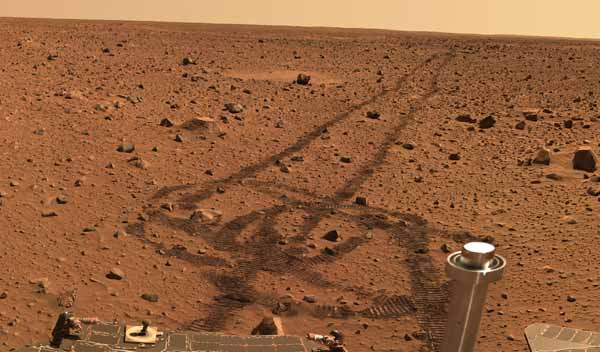 Image Credit: NASA/JPL |
|
Here are the tracks left by Spirit as it drove across Mars. |
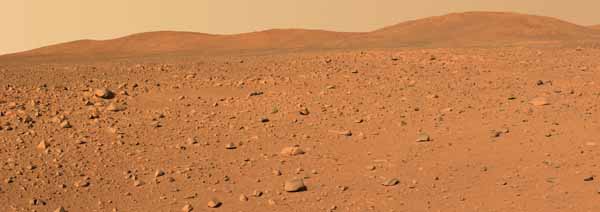 Image Credit: NASA/JPL |
|
But as interesting as the road behind may be, the road ahead is always so much more fascinating. |
Dateline: Saturn
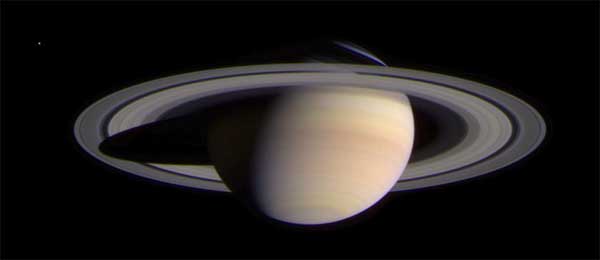
Image Credit: NASA/JPL |
|
The picture above shows a true color image of Saturn as seen by Cassini prior to Saturn Orbit Insertion. |
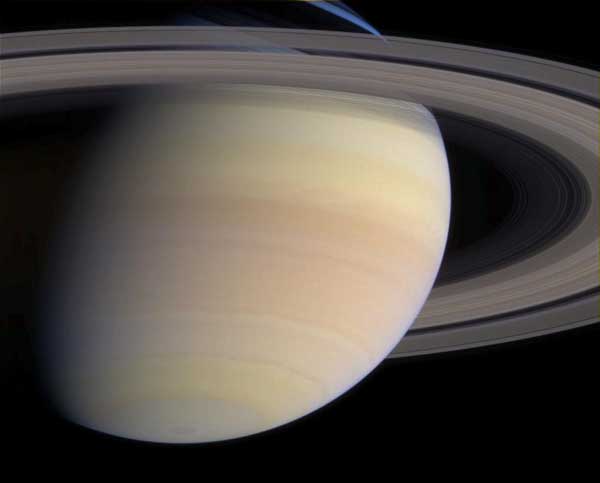
Images Credit: NASA/JPL |
|
Here's a closer view of Saturn. |
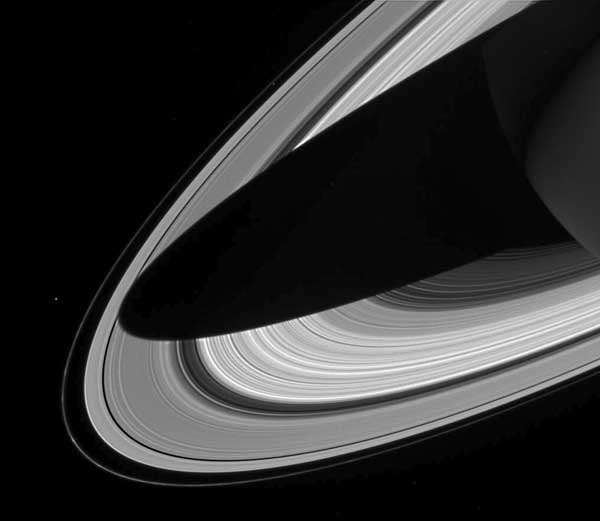 Image Credit: NASA/JPL |
|
This gray-scale image of Saturn's rings, and the planet's shadow falling across the rings, shows detail that cannot be seen with Earth-based telescopes. At the time this picture was taken the spacecraft was just under a million miles from Saturn. The historical view concerning Saturn's rings was that there were only a few of them and that they were separated from each other by gaps that were devoid of ring particles. The two Voyager spacecraft, in the early 1980's, showed that this was not the case. They found that Saturn has thousands of small rings and that even the gaps between the rings contained particles, just not as many as in the rings themselves. |
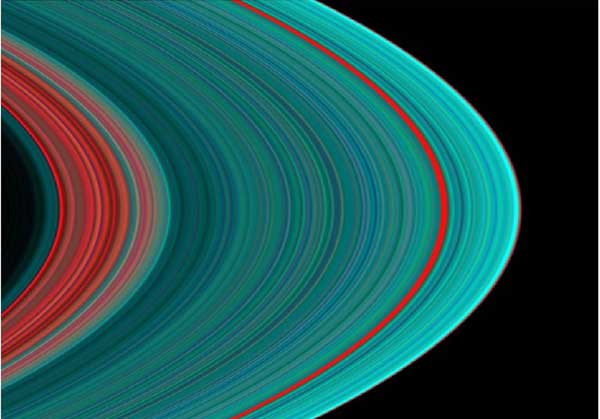
Images Credit: NASA/JPL |
|
This false color image of Saturn's rings was taken using the spacecraft's Ultraviolet Imaging Spectrograph during the time of Saturn Orbit Insertion. The full resolution version of this image shows details as small as 60 miles across, which is roughly 100 times smaller than those seen by the two Voyager spacecraft. The turquoise colors in this image correspond to ring particles that have a more icy composition whereas the red colors correspond to particles that are more rocky or perhaps smaller. Studies of the composition of the ring particles and how those particles are distributed within the ring system will tell scientists much about the origin and development of Saturn's rings. |
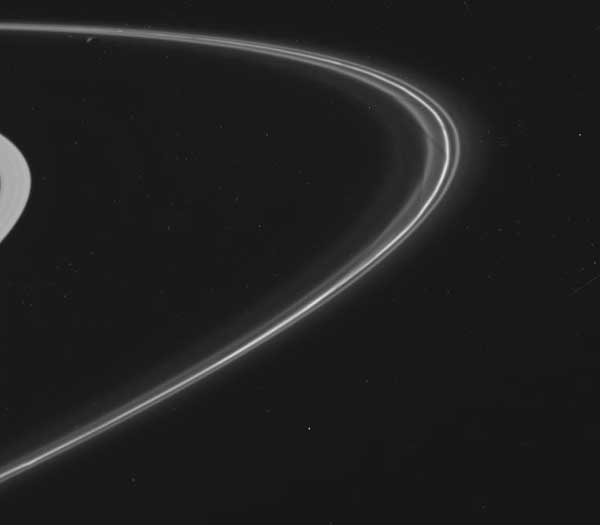 Image Credit: NASA/JPL |
|
This picture, which was taken after Cassini had entered into orbit around Saturn, shows the planet's F ring. This is the ring that looks like a series of ropes that have been braided together. Scientists continue to argue about its nature and origin. Perhaps the on-going observations from Cassini will shed some light on this mystery. |

Images Credit: NASA/JPL |
|
Shown above are two images of Saturn's largest moon, Titan. On the left is a true color image taken from a distance of 8.2 million miles (13.1 million kilometers) showing what can be seen with the human eye, i.e. not very much. Titan's atmosphere is cloudy and covered by a photochemical smog that is rich in organic materials, making that moon appear to be nothing more than a featureless orange ball. If we were restricted to seeing the universe with just our human eyes, then we'd not be able to see the surface of Titan. But we don't have to suffer from the limitations of our senses, we can go beyond them. Titan's cloudy atmosphere is opaque to visible light but partially transparent to infrared light. Our eyes can't see infrared wavelengths, but the camera on Cassini can. By taking pictures of Titan using infrared radiation we can see through those clouds and get a hint about what's on the surface of Titan. In the false color image on the right, which was taken through three different infrared filters, we can see features on Titan's surface. The yellow areas are places rich in hydrocarbons, the green areas are icy regions and that bright white spot near the bottom of the picture is a methane cloud. In the upper part of the image is a large circular feature that may be an impact crater. As the Cassini mission progresses we can expect to see many more - and much more detailed - images of the surface of a world that has heretofore been hidden from us by distance and a cloudy atmosphere. Who knows what we will see? |
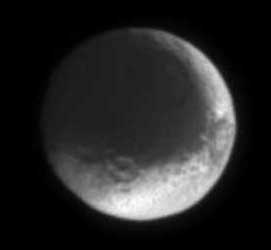
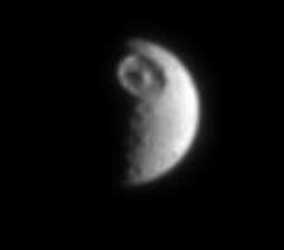
Iapetus Mimas Image Credit: NASA/JPL |
|
And finally, we have pictures of two of Saturn's moons that have something of a science fictional connection. On the left is a picture of Iapetus, which played an important part in the novel 2001: A Space Odyssey. In the book, as in real life, Iapetus was described as being a 'two-faced' world, with one hemisphere being about 10 times brighter than the other. This strange fact was first discovered by telescopic observations from the Earth and later confirmed by the Voyager spacecraft. In the picture of Iapetus you can see a large dark splotch. That isn't a trick of light and shadow, it's a real feature on the surface of Iapetus. But its origin and nature are a complete unknown. {Though we can probably rule out the presence of a large black monolith.} And what can we say about Mimas? {Other than that it's real and it wasn't created by George Lucas.} When this moon was first seen by the Voyager spacecraft in the early 1980's everyone's jaw dropped in surprise because it looked so much like the Death Star Battle Station from Star Wars. Some of the scientists and reporters even took to calling Mimas "the Death Star Moon". {And I don't care what anyone says, if Cassini stops working after it has a close encounter with Mimas, I'm going get nervous.} That large crater near the top of the image is called Herschel and is 80 miles (130 kilometers) wide and 6 miles (10 kilometers) deep. This crater is almost 1/3 the diameter of Mimas - 247 miles (398 kilometers). If the impacting object that created this crater had been any bigger - or had been moving any faster - then it might have shattered Mimas into a cloud of debris. One final note. The two pictures above are not displayed at the same scale. Iapetus is larger than Mimas, being 892 miles in diameter vs 247 miles for Mimas. |
Listen to this show | |

|
|
Links for more information relating to this show
|
Kim Stanley Robinson
Burt Rutan and the X-Prize The Cassini Mission to Saturn Space Related Organizations If you are interested in learning more about current space activities there are many local and national organizations you might want to know about. Joining these organizations and taking part in their activities is a good way to stay abreast of things going on in space as well as a way to show your support for those activities. Listed below are some of those organizations. Space News - Mars For On-Going Updates on Space News ISS News |
Copyright © Warren W. James, 2000-2004. All rights reserved.